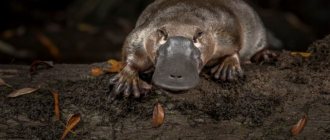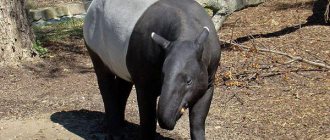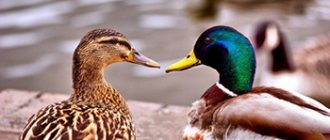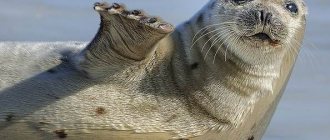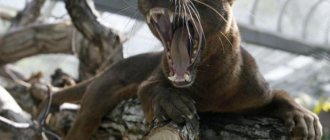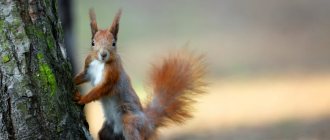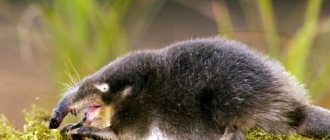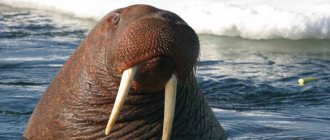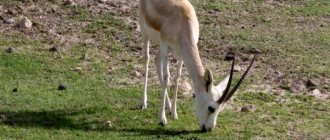The platypus is a waterfowl mammal that lives in the fresh waters of Australia. Thanks to its unique features and unusual appearance, the animal was recognized as one of the symbols of the continent.
Hunting and pollution of the water bodies in which the platypus lives has led to a noticeable decline in its numbers in the last century. The population was also negatively affected by the excessive reproduction of rabbits brought to Australia, which by digging holes scared away waterfowl from their habitable places.
The animal is currently under constant surveillance. The ban on hunting platypuses and the creation of reserves with favorable conditions had a positive effect on the restoration of their numbers. Currently, the platypus is listed in the Red Book under the status of LC (species of least concern).
Who is the platypus
Hello
At first glance at an animal it is quite difficult to determine whether it belongs to any class: platypuses, unlike other mammals, have characteristics that make them similar to reptiles and birds.
The history of studying the species began in the 18th century, when the first animal skins came to Europe. For a long time, scientists could not come to a consensus as to what class of animals the egg-laying platypus belongs to, until it was finally established that females feed their young with milk.
In modern taxonomy, it is generally accepted that the platypus is a mammal from the order of monotremes (oviparous). The genus of echidnas belongs to the same order. The main feature of the representatives of the order is the presence of one passage connecting the exits of the intestines and the urogenital sinus.
Population and species status
Photo: Platypus animal
Due to poachers and hunters who exterminated platypuses in large numbers in pursuit of wool, the platypus family was almost completely destroyed at the beginning of the 20th century. In this regard, hunting these animals was completely prohibited.
Today, the animal is not in danger of complete extinction, but its habitat has shrunk significantly. This is due to the pollution of water bodies and the development of large territories by humans. Rabbits brought by colonists are also reducing their habitats. They dig holes in the places where the animals live and force them to look for other habitats.
What does a platypus look like?
Drawing
The description of the animal is quite unusual:
- The body is elongated, with a large wide tail located at the back, in which a supply of nutrients accumulates. The entire skin, including the tail, is covered with soft, thick fur of a dark brown or dark gray hue.
- The platypus skull is round, with two arched bones located in front, forming a flat beak 5-6 cm long.
- The nose only in appearance resembles a duck's beak: it is not hard, like a bird's, and is covered with skin on top.
- The appearance of the platypus is complemented by paws with leathery swimming membranes. If necessary, the animal can bend the edges of the membranes inward, releasing sharp long claws, which it uses to tear the soil at the bottom of the reservoir in search of food.
Platypus skeleton
Platypus dimensions
The average body length of a platypus is 30-40 cm, with males noticeably larger than females. The tail can reach a length of 15 cm. The weight of the animal varies from 1.5 to 2 kg.
History of discovery
Strange creatures boast an unusual history of their discovery. The first description of the platypus was given by Australian pioneers in the early 18th century. For a long time, science did not recognize the existence of platypuses and considered the mention of them to be an inept joke by Australian residents. Finally, at the end of the 18th century, scientists at a British university received a parcel from Australia containing the fur of an unknown animal, similar to a beaver, with paws like an otter, and a nose like an ordinary domestic duck. Such a beak looked so ridiculous that scientists even shaved the hair on the face, believing that Australian jokers had sewn a duck nose to the skin of a beaver. Finding no seams or traces of glue, the pundits simply shrugged their shoulders. No one could understand where the platypus lived or how it reproduced. Only a few years later, in 1799, the British naturalist J. Shaw proved the existence of this miracle and gave the first detailed description of the creature, which was later given the name “platypus.” Photos of the bird beast can only be taken in Australia, because this is the only continent on which these exotic animals currently live.
Where does the platypus live?
The natural habitat of the platypus is the eastern part of Australia and the island of Tasmania. Probably, small populations lived in the central and western parts of the continent, but today it is generally accepted that the species has completely disappeared in these areas.
Where do platypuses live?
Diagram of a hole with two entrances
The usual habitat of the platypus is the coastal zone of fresh water bodies. The animal chooses a steep bank with vegetation to build its home. Platypuses dig long burrows with a camera. The habitat has two exits: one of them is below the water level, and the second is at a height of at least a meter above the water. To camouflage their homes, platypuses arrange entrances to their homes in the roots of trees, in dense thickets of bushes or algae.
Features of character and lifestyle
Photo: Australian platypus
Animals tend to spend a third of their lives in water. These animals tend to hibernate. It can last 6-14 days. Most often, this phenomenon is observed before the onset of the mating season. Thus, the animals gain strength and rest.
The platypus is most active at night. At night he hunts and gets his food. These representatives of the duckbill family prefer an isolated lifestyle. It is unusual for them to form groups or create families. By nature, platypuses are endowed with excessive caution.
Platypuses inhabit mainly coastal areas of water bodies. Due to their unique ability to regulate body temperature and perfectly adapt to environmental conditions, they settle near not only warm rivers and lakes, but also near cold high-mountain streams.
For permanent residence, adult individuals create tunnels and burrows. They dig them with strong paws and large claws. The burrow has a special structure. It has two entrances, a small tunnel and a spacious, cozy inner chamber. Animals build a hole in such a way that the entrance corridor is narrow. While moving along it into the inner chamber, all the liquid on the platypus’s body is squeezed out.
What does the platypus eat?
With booty
Most of the platypus' diet consists of mollusks, crustaceans, invertebrates, and insects that live on the bottom and in the upper layer of silt. It dives to the bottom, breaks the mud with its paws or nose and looks for prey. When there is a shortage of animal food, the platypus can feed on aquatic vegetation.
The lower part of the beak has narrow channels resembling a sieve, which allows the platypus to strain the food it has caught, which it then hides in its cheek pouches. After diving, it emerges to the surface and remains there for some time, grinding the food collected in its mouth with the help of horny plates and teeth located in the oral cavity.
The platypus eats a lot: per day it consumes an amount of food equal to a quarter of its own weight.
Lifestyle
Diving to depth
Platypuses are active at night. They go hunting in the evening and stay in the water for 10-12 hours, after which they rest in a hole. The platypus is capable of staying underwater for up to 5 minutes, descending to a depth of 7 m.
When diving under water, the nostrils, eyes and ear openings are closed by valves. To orient itself in space, the animal uses its beak, which contains many nerve endings. This is one of the few animals capable of electrolocation - capturing electric and magnetic fields.
Platypuses do not gather in flocks and lead an isolated lifestyle. Each individual lives separately in its own hole and hunts in a certain territory.
On temporary maintenance
The animal is very cautious, timid and does not adapt well to new conditions. Many attempts to export waterfowl mammals abroad for placement in zoos and zoos have ended in failure.
Platypuses are protected and are prohibited from being taken from the continent or kept as pets. An exception may be temporary keeping for further release into the natural habitat, or keeping an injured animal that is not capable of independent life in nature.
How does the platypus reproduce?
mating dance
The breeding season begins after a short winter hibernation. It usually begins in August and can last for 2-3 months. Platypuses are ready to reproduce at the age of 1 year. Before mating, the male courts the female, and several different ways of showing attention to the opposite sex are known. Platypuses are not monogamous animals: each male can cover several females.
How platypuses care for their offspring
Nora
After the mating season ends, care for the offspring falls entirely on the female. She begins preparing for the birth of her young by building a separate nest: she digs a hole with a chamber, which she lines with grass and leaves, and closes the passages with earthen plugs.
The maturation of eggs in the female reproductive system lasts 14 days. Typically, a platypus lays 1-2 eggs. They are small, round in shape, the shell has a leathery structure.
Until the birth of the offspring, the female incubates the eggs almost continuously, warming them with her body.
How is it born
The baby platypus is born by breaking through the egg from the inside with its egg tooth. The female does not have the usual mammary glands, so for a long time the fact that the platypus feeds its young with milk remained unclear.
Newborn
The feeding process occurs in a somewhat unusual way. The nutrient fluid formed under the skin appears on the surface of the skin through the pores. This creates the impression that the female is sweating milk. As it accumulates, it flows into the folds of the skin, from where the cubs lick it off.
feeding
In the first three months, babies remain blind and are completely dependent on their mother. She leaves them rarely and for short periods. The female platypus feeds the cubs until 4-4.5 months, after which they practically stop feeding on milk and go out to hunt on their own.
I myself
HARE
Waiting for the Cubs
A month after mating, the platypus digs a long, deep hole, filling it with armfuls of wet leaves and brushwood. The female carries everything she needs, wrapping her paws around her and tucking her flat tail under. When the shelter is ready, the expectant mother lies down in the nest and covers the entrance to the hole with earth. The platypus lays its eggs in this nesting chamber. The clutch usually contains two, rarely three, small whitish eggs, which are glued together with a sticky substance. The female incubates the eggs for 10-14 days. The animal spends this time curled up in a ball on the masonry, hidden by wet leaves. At the same time, the female platypus can occasionally leave the hole in order to have a snack, clean itself and wet its fur.
Why is the platypus poisonous?
Poisonous Spur
Unlike fish and reptiles, among which poisonousness is often found, mammals use sharp claws and teeth, powerful tusks or horns to protect and capture prey. The platypus is one of the few animals capable of producing poison and injecting it into an attacker or victim. To do this, it uses poisonous spines located on its hind legs.
Venom gland
The spines resemble the spurs of birds in appearance. They are noticeable in newly hatched cubs of both sexes, but as females grow older, the spurs stop developing and atrophy. In adult males, each spur is connected by a duct to the sacral gland, in which poison is produced. Toxic substances are formed especially intensively during the mating period of platypuses.
When defending or attacking, the platypus strikes with its hind paw, driving the spine as deep as possible, and injects poison. The toxic substance is a mixture of almost 20 different components. Moreover, it contains more effective D-toxins, while most poisonous species contain relatively weak L-toxins.
The poison that enters the body of a small animal acts on the heart, causing it to stop. There are known cases of deaths of dogs used by hunters to catch animals. Platypus venom is not fatal to large animals and humans, but it can cause significant harm to health. So, after an animal attack, extensive swelling forms at the site of the impact and quite severe pain appears. People who have survived a platypus attack report that the damaged limb becomes more sensitive to pain, and they also experience limited mobility during physical activity.
Origin
The appearance of platypuses dates back to those distant times when modern continents did not exist. All land was united into one huge continent - Gondwana. It was then, 110 million years ago, that platypuses appeared in terrestrial ecosystems, taking the place of recently extinct dinosaurs. Migrating, platypuses settled throughout the continent, and after the collapse of Gondwana, they remained to live on a large area of the ex-continent, which was later named Australia. Due to the isolated location of their homeland, the animals have retained their original appearance even after millions of years. Various species of platypuses once inhabited the vast expanses of the entire land, but only one species of these animals has survived to this day.
Enemies of the platypus
Sand monitor
The animal's natural enemies are sand lizards, pythons and some species of seals that swim from the ocean to river mouths.
Australian python
The main reason for the decline in the number of platypuses is human activity: for a long time, animals were caught for fur; many individuals died after becoming entangled in fishing nets. Climate change and an increase in water withdrawals for domestic consumption, agricultural irrigation and industrial needs have led to a decrease in water levels and a deterioration in its quality.
KANGAROO
Interesting facts about the platypus
Platypus on a gold coin
- Researchers have discovered fossils indicating that in ancient times platypuses were much larger than their modern descendants: their length from head to rump reached 1 m.
- The platypus has a fairly low metabolic rate, so its normal temperature is only 32 degrees. With a long stay in cold water, the animal is able to maintain a stable body temperature by accelerating metabolic processes.
- Based on the information obtained as a result of excavations, a theory was built about how platypuses appeared. The origin of the species is believed to be associated with one of the earliest branches of mammalian development. Its historical homeland is the territory of modern South America, which more than 180 million years ago was part of a single continent along with modern Australia, Africa and New Zealand. After the split of the continent, the oviparous species living on it survived only in Australia. On other continents they find the remains of extinct animals that are relatives of the platypuses that have survived to this day.
- One of Australia's coins features the platypus as an iconic symbol of the continent. In addition to the usual 20 cent coins that are used in everyday life, the Perth Mint of Australia produces bullion coins with the image of this animal.
Relationships with people
At the beginning of the last century, these amazing animals were on the verge of extinction. Australian poachers were decimating the population in pursuit of their valuable fluffy fur. To make one fur coat, about 60 skins of defenseless animals were required. Fortunately, a ban on catching these animals was introduced, which helped save them from complete destruction.
Nowadays the population is safe. The platypus can rightfully be considered an indigenous resident of Australia, who does not want to change his place of residence to any other continent. For this, local residents have recognized the animal as a symbol of the country and protect it as much as possible from poachers.
